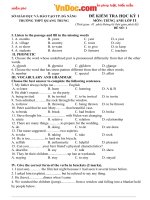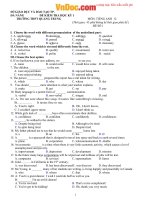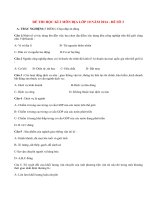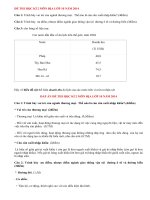Đề thi học kì 1 môn Tiếng Anh 10 năm 2019-2020 có đáp án - Sở GD&ĐT Bắc Ninh
Bạn đang xem bản rút gọn của tài liệu. Xem và tải ngay bản đầy đủ của tài liệu tại đây (357.65 KB, 9 trang )
UBND TỈNH BẮC NINH
SỞ GIÁO DỤC VÀ ĐÀO TẠO
ĐỀ THI HỌC KÌ I NĂM HỌC 20192020
Môn thi: TIẾNG ANH – KHỐI 10
Thời gian làm bài: 60 phút
A LISTENING (2.0 pts)
Hướng dẫn kiểm tra nghe: Nội dung kiểm tra nghe gồm 02 phần. Thí sinh được nghe mỗi phần 02 lần
liên tiếp. Mở đầu có tín hiệu nhạc. Thời gian đọc đề bài được mặc định trong đĩa CD.
I. Listen to the news about the benefits of eating plant protein and choose the correct answer A, B,
C or D to fill in the gap in each of the following questions (1.0 pts)
Question 1. (NB) Researchers ______ almost 71,000 middleaged Japanese adults for an average of
almost 20 years.
A. follow B. followed C. investigated D. researched
Question 2. (NB)The researchers found that those who ate the most were _____ percent Less likely to die
during the study.
A. 13 B. 30 C. 15 D. 50
Question 3. (TH) Mr. Frank Hu told the Reuters news service that earlier studies have shown that eating
more animal protein is linked to _____ disease and death.
A. dangerous B. serious C. chronic D. infectious
Question 4 (VD) He said earlier studies also have shown that eating more plant protein is linked with
lower _____ risks.
A. healthy B. unhealthy C. healthier D. health
Listen to the next part of the news about the benefits of eating plant protein and fill in each gap
with one word you hear (1.0p).
Animal protein did not appear to influence length of life in the study, researchers report in the scientific
publication JAMA Internal Medicine. During the study, 12,381 people died. That included more than
(1)_____ deaths from cancer, 3,025 from cardiovascular disease and 1.528 deaths from other kinds of
heart disease. The remaining deaths were the result of cerebrovascular disease.
People who replaced just 3 percent of red meat with plant protein were 34 percent less likely to die of any
cause. They were 39 percent less likely to die of (2)_____, and 42 percent less likely to die of heart
disease during the study.
And, those who replaced just 4 percent of processed meat in their (3) ______ high with plant protein were
46 percent less likely to die of any cause. They were 50 percent less likely to die of cancer.
Hu was not involved in the Japanese study. But he said when individuals eat more plant protein foods
such as nuts and lentils, there is major improvement in cardiovascular risk (4) ___. These include blood
pressure and body weight.
B. VOCABULARY AND GRAMMAR (2.5 pts).
I. Mark the letter A, B, C, or D on your answer sheet to indicate the word whose underlined part
differs from the other three in pronunciation in each of the following questions. (0.5 pts)
Question 1. (TH)
A. request B. arrest
C. invest D. dearest
Question 2. (NB)
A. movement B. advertisement
C. comment D. announcement
II. Choose the best answer A, B, C or D for each of the following sentences (1.0 pt).
Question 1. (TH) We ______ to a piece of music when he arrived for a novel by Leo Tolstoy.
A. listened
B. are listening
C. will listen D. were listening
Question 2. (TH) _____ breaks out the food we eat and turns it into energy.
A. Respiratory system
B. Digestive system
C. Nervous system
D. Circulatory system
Question 3. (TH) Listen to the wind! We ______ a hard crossing.
A. will have B. had
C. are going to have
D. were having
Question 4. (VD) The concert was exciting at the beginning, ___it became boring at the end.
A. or B. but
C. so D. and
III. Give the correct tense or form of the given verb in each of the following sentences (1.0pt.)
Question 1. (NB) Mr. Long (work) ______ in an office every day, but now he is helping his wife to
prepare dinner.
Question 2. (TH) My mother gets annoyed with my younger brother because he always (throw) ______
his dirty clothes over the floor.
Question 3. (TH) They advised her (not quit) _______ her secondary school until she have finished it.
Question 4. (VD) What you (do) _____ when I phoned you yesterday?
C. READING (2.0 pts).
Read the passage carefully and answer the given questions.
Family types vary in different countries and among different cultures. In Western, industrialized societies,
the nuclear family ranks as the most common family type. It consists of a father, a mother and their
children. But nuclear families exist together with many other types of family units. In the singleparent
family, for example, a mother or a father heads the family alone. A blended family is formed when a
divorced or widowed parent remarries. As divorce rate has risen, the number of singleparent and blended
families has increased.
In many parts of the world, parents and children live together with other family members under the same
roof. These complex families usually contain several generations of family members, including
grandparents, parents and children. They may also include brothers of sisters and their families, uncles,
aunts and cousins. Even when relatives do not live together, they still consider themselves members of the
same extended family including grandparents, uncles, aunts and cousins.
Question 1. (NB) Which family type ranks as the most common one in Western industrialised societies?
Question 2. (TH) What does a nuclear family consist of?
Question 3. (NB) Has the rise in divorce rate increased the number of singleparent and blended
families?
Question 4. (VD) How many generations does an extended family usually contain?
D. WRITING (1,5 pts).
Rewrite the following sentences beginning with the given words or phrases so that they have the
closest meanings to the given ones.
Question 1. (TH) The bones in the skeletal system support all the body organs.
=> All the body organs ___________.
Question 2. (VD) She has decided to go to Finland for a study tour.
=> She has made a ________.
Question 3. (VD) My father doesn’t let us go out at night.
=> We aren't ___________.
THE END
HƯỚNG DẪN GIẢI
Thực hiện: Ban Chuyên môn Loigiaihay.com
A. LISTENING (2.0 pts)
I. 1B 2A 3C 4D
II.
1. 5055
2. cancer
3. diet
4. factors
B. VOCABULARY AND GRAMMAR
I. 1D 2C
II. 1D 2B 3C 4B
III. 1/ works 2/throws 3/ not to quit 4/were you doing
C. READING (2.0 pts).
Read the passage carefully and answer the given questions.
Question 1. the nuclear family
Question 2. a father, a mother and their children
Question 3. Yes, It has
Question 4. several generations of family members, including grandparents, parents and children
D. WRITING (1,5 pts).
Rewrite the following sentences beginning with the given words or phrases so that they have the
closest meanings to the given ones.
Question 1. All the body organs are supported by the bones in the skeletal system.
Question 2. She has made a decision to go to Finland for a study tour.
Question 3. We aren't allowed to go out at night (by my father).
GIẢI CHI TIẾT ĐỀ THI
B. VOCABULARY AND GRAMMAR
I. Mark the letter A, B, C, or D on your answer sheet to indicate the word whose underlined part
differs from the other three in pronunciation in each of the following questions. (0.5 pts)
Question 1. D
Kiến thức: Phát âm “est”
Giải thích:
request /rɪˈkwest/
arrest
/əˈrest/
invest /ɪnˈvest/
dearest /ˈdɪə.rɪst/
Đáp án D phát âm là /ist/ còn lại là /est/
Chọn D
Question 2. C
Kiến thức:
Giải thích:
movement /ˈmuːv.mənt/
advertisement /ədˈvɜː.tɪs.mənt/
comment /ˈkɒm.ent/
announcement /əˈnaʊns.mənt/
Đáp án C phát âm là /ment/ còn lại là /mənt/
Chọn C
II. Choose the best answer A, B, C or D for each of the following sentences (1.0 pt).
Question 1. D
Kiến thức: Sự hòa hợp về thì
Giải thích:
Cấu trúc câu khi một sự việc đang diễn ra thì 1 việc khác chen vào: S + V(quá khứ tiếp diễn) when +
S + V (quá khứ đơn)
=> We were listening to a piece of music when he arrived for a novel by Leo Tolstoy.
Tạm dịch: Chúng tôi đang nghe nhạc khi anh ta đến mượn cuốn tiểu thuyết của Leo Tolstoy.
Chọn D
Question 2. B
Kiến thức:
Giải thích:
Respiratory system: hệ hô hấp
Digestive system: hệ tiêu hóa
Nervous system: hệ thần kinh
Circulatory system: hệ tuần hoàn máu
=> Digestive system breaks out the food we eat and turns it into energy.
(Hệ tiêu hóa nghiền nát thức ăn rồi chuyển hóa thành năng lượng)
Chọn B
Question 3. C
Kiến thức: Thì tương lai
Giải thích:
be going to V: kế hoạch có từ trước, một sự khẳng định có căn cứ
will + V: suy đoán, không có căn cứ
=> Listen to the wind! We are going to have a hard crossing.
Tạm dịch: Lắng nghe tiếng gió đi. Chúng ta sẽ phải băng qua 1 đoạn đường khó khăn đấy.
Chọn C
Question 4. B
Kiến thức: Liên từ
Giải thích:
Các liên từ nối:
or: hoặc là (giả định không thế này thì thế khác)
but: nhưng mà
so: do đó, vậy nên
and: và
2 vế của câu chỉ sự đối lập khi bắt đầu và kết thúc.
=> The concert was exciting at the beginning, but it became boring at the end.
Tạm dịch: Buổi hòa nhạc rất hào hứng lúc ban đầu nhưng khi kết thúc lại trở nên nhàm chán.
Chọn B
IIl. Give the correct tense or form of the given verb in each of the following sentences (1.0pt.)
Question 1. works
Kiến thức: Thì hiện tại đơn
Giải thích:
dấu hiệu everyday => chỉ thói quen ở hiện tại
Chủ ngữ là Mr.Long số ít nên động từ phải thêm đuôi –s/es
=> Mr. Long works in an office every day, but now he is helping his wife to prepare dinner.
Tạm dịch: Ông Long làm việc ở cơ quan mỗi ngày, nhưng bây giờ ông ấy lại đang giúp vợ mình chuẩn
bị bữa tối.
Question 2. throws
Kiến thức: Thì hiện tại đơn
Giải thích:
Dấu hiệu “always” => thì hiện tại đơn với chủ ngữ là he => động từ thêm đuôi –s/es
=> My mother gets annoyed with my younger brother because he always throws his dirty clothes over the
floor.
Tạm dịch: Mẹ tôi luôn phiền lòng vì em trai tôi bởi vì nó luôn vứt quần áo bẩn lên sàn nhà.
Question 3. not to quit
Kiến thức: Cấu trúc với advise
Giải thích:
Sử dụng cấu trúc: advise sb (not) to V: khuyên ai đó (không) nên làm gì
=> They advised her not to quit her secondary school until she have finished it.
Tạm dịch: Họ khuyên cô ấy không dừng việc học trung học của mình cho đến khi hoàn thành nó.
Question 4. were you doing
Kiến thức: Sự hòa hợp về thì
Giải thích:
Hỏi về một thời điểm cụ thể trong quá khứ “when I phoned you yesterday” đang làm gì? Thì sử dụng
thì quá khứ tiếp diễn.
=> What were you doing when I phoned you yesterday?
Tạm dịch: Bạn đang làm gì khi tôi gọi vào tối qua?
C. READING (2.0 pts).
Read the passage carefully and answer the given questions.
Tạm dịch bài
Các loại gia đình khác nhau ở các quốc gia khác nhau và giữa các nền văn hóa là khác nhau. Ở phương
Tây, các xã hội công nghiệp hóa, gia đình hạt nhân được xếp hạng là loại gia đình phổ biến nhất. Nó
bao gồm một người cha, một người mẹ và những đứa con của họ. Nhưng gia đình hạt nhân tồn tại
cùng với nhiều loại đơn vị gia đình khác. Trong gia đình cha mẹ đơn thân, ví dụ, một người mẹ hoặc
người cha đứng đầu gia đình một mình. Một gia đình hỗn hợp được hình thành khi cha mẹ ly dị hoặc
góa vợ tái hôn. Khi tỷ lệ ly hôn tăng lên, số lượng gia đình đơn thân và gia đình hỗn hợp đã tăng lên.
Ở nhiều nơi trên thế giới, cha mẹ và con cái sống cùng với các thành viên khác trong gia đình dưới
cùng một mái nhà. Những gia đình phức tạp này thường chứa một vài thế hệ thành viên trong gia đình,
bao gồm ông bà, cha mẹ và con cái. Họ cũng có thể bao gồm anh em của chị em và gia đình, chú bác,
cô dì và anh em họ của họ. Ngay cả khi người thân không sống cùng nhau, họ vẫn coi mình là thành
viên của cùng một đại gia đình bao gồm ông bà, chú bác, cô dì và anh em họ.
Kiến thức chung: Đọc hiểu
Question 1.
Giải thích:
Which family type ranks as the most common one in Western industrialised societies?
Kiểu gia đình nào là phổ biến nhất ở các quốc gia công nghiệp của phương tây?
Đáp án: the nuclear family
Thông tin: In Western, industrialized societies, the nuclear family ranks as the most common family type.
Tạm dịch: Ở phương Tây, các xã hội công nghiệp hóa, gia đình hạt nhân được xếp hạng là loại gia
đình phổ biến nhất.
Question 2.
Giải thích:
What does a nuclear family consist of?
(Gia đình hạt nhân bao gồm thành phần nào?)
Đáp án: a father, a mother and their children
Thông tin: Câu số 3 trong bài “It consists of a father, a mother and their children.”
Tạm dịch: Bao gồm: bố, mẹ và các con”
Question 3.
Kiến thức:
Giải thích:
“Has the rise in divorce rate increased the number of singleparent and blended families?”
(Tỉ lệ li dị tăng làm cho số lượng của bố mẹ đơn thân và gia đình có cha hoặc mẹ kế cũng tăng?)
Đáp án: Yes, It has
Thông tin: (Câu cuối đoạn 1) “As divorce rate has risen, the number of singleparent and blended
families has increased.”
Tạm dịch: Khi tỉ lệ li dị tăng thì số lượng số mẹ đơn thân và gia đình có cha/mẹ kế cũng tăng”
Question 4.
Giải thích:
How many generations does an extended family usually contain?
(Có bao nhiêu thế hệ trong một gia đình “mở rộng”?)
Đáp án: several generations of family members, including grandparents, parents and children
Tạm dịch: Có vài thế hệ trong gia đình bao gồm ông bà, bố mẹ và con cái.
Thông tin (đoạn 2)
D. WRITING (1,5 pts).
Rewrite the following sentences beginning with the given words or phrases so that they have the
closest meanings to the given ones.
Question 1.
Kiến thức: Câu bị động
Giải thích:
Cấu trúc câu bị động với thì hiện tại đơn: S+ to be(am/is/are) + Vp2 + by + O
Trong đó: S : All the body organs
to be: are (vì chủ ngữ số nhiều)
Vp2: support – supported
=> All the body organs are supported by the bones in the skeletal system.
Tạm dịch: Tất cả các cơ quan trong cơ thể đều được chống đỡ và bảo vệ bởi hệ thống xương.
Question 2.
Kiến thức: Cấu trúc với decision
Giải thích:
Cụm từ cố định: make a decision: = decide: quyết định việc gì
=> She has made a decision to go to Finland for a study tour.
Tạm dịch: Cô ấy đã quyết định đến Phần Lan để du lịch trải nhiệm giáo dục
Question 3.
Kiến thức: Cấu trúc với allow
Giải thích:
Cấu trúc cố định: allow sb to V = let sb V: cho phép ai làm gì
Trong câu trên chủ ngữ “we” được đặt lên đầu câu nên phải sử dụng câu bị động
=> We aren't allowed to go out at night (by my father).
Tạm dịch: Chúng tôi không được phép ra ngoài vào buổi tối.
THE END









